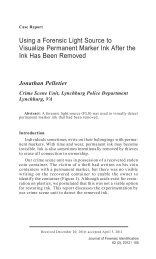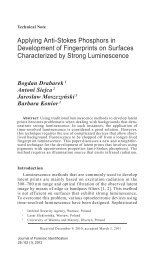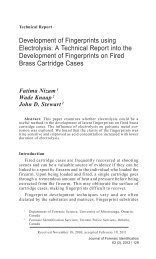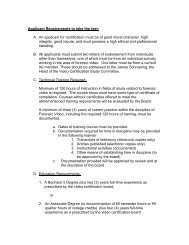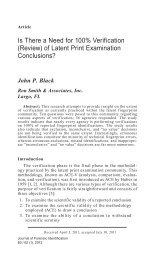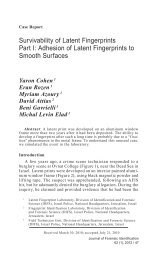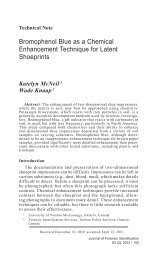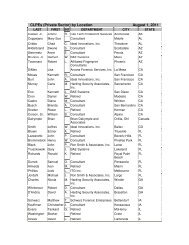Individualization Using Friction Skin Impressions: Scientifically ...
Individualization Using Friction Skin Impressions: Scientifically ...
Individualization Using Friction Skin Impressions: Scientifically ...
Create successful ePaper yourself
Turn your PDF publications into a flip-book with our unique Google optimized e-Paper software.
or body of principles offered to explain phenomena”. Once a law<br />
has been established after rigorous observation and a theory has<br />
been established that explains the law through the accumulation<br />
of tested hypotheses, it is imperative that research be continuously<br />
undertaken in an effort to disprove the law or the theory.<br />
At any time, the law or the theory explaining the law may be<br />
shown to be wrong or may need to be modified if there is data<br />
to suggest so. As seen in every discipline of science, nothing in<br />
science is ever proven to the most absolute sense. However, each<br />
failed attempt to disprove the law or the theory adds additional<br />
knowledge and support for that law and theory.<br />
Uniqueness Premise<br />
The science of friction ridge skin examination, which is<br />
based on the premise that the arrangement of friction ridges<br />
are unique, and therefore can be individualized to a single<br />
source of friction skin, began as an observation more than three<br />
hundred years ago. In 1684, Dr. Nehemiah Grew, followed by G.<br />
Bidloo in 1685, began observing ridge and pore structures at a<br />
macroscopic level. Marcello Malpighi, using the newly invented<br />
microscope, studied the function and structure of friction skin<br />
at the microscopic level in 1686 [20–22]. Data from these initial<br />
observations continued to accumulate and in 1788, a common<br />
result from these observations was first stated by J. C. A. Mayer<br />
“that the arrangement of skin ridges is never duplicated in two<br />
individuals” [20]. This statement of order and relation of friction<br />
ridges has been observed since 1684 and continues to be invariably<br />
observed today.<br />
The first systematic use of friction ridge skin for personal<br />
identification was established by Sir William Herschel in 1860.<br />
In 1880, it was suggested by Dr. Henry Faulds that fingerprints<br />
may be used for personal identification and the detection of<br />
criminals in a letter to the editor of Nature. By 1892, the premise<br />
of friction ridge skin uniqueness had accumulated a mass of<br />
supporting empirical data, and the first statistical test was<br />
performed by Sir Francis Galton in an effort to determine the<br />
theoretical possibility that the arrangement of friction ridges<br />
is duplicated in two individuals. As the National Academies of<br />
Science has cited, Galton estimated that the probability of two<br />
fingerprints being duplicated from two sources of friction skin<br />
was “less than the reciprocal of 40 times the world population<br />
at that time” [3].<br />
Journal of Forensic Identification<br />
62 (1), 2012 \ 65



